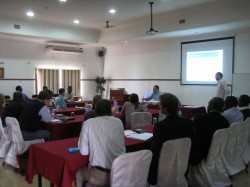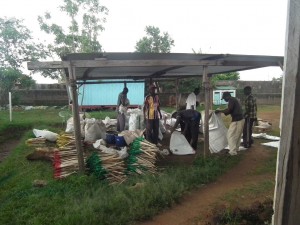On a recent sunny Friday in Lilongwe,
IPA Malawi hosted its first Research Discussion. These events provide policy-makers and practitioners with a forum to discuss IPA research projects, research findings, and other poverty research-related issues in Malawi. IPA affiliate
Jon Robinson has been working in Western Kenya for over ten years, studying how to increase farm productivity through encouraging use of fertilizer and other agricultural inputs. This work has particular relevance for Malawi, where the government operates one of the most widespread agricultural subsidy programs in the world, and officials are particularly interested in any program that can help existing farms be more productive.

Over 25 people from various organizations such as the Ministry of Agriculture,
International Food Policy Research Institute,
International Institute of Tropical Agriculture, and the Malawian Bunda College of Agriculture, gathered in Lilongwe. Jon, Assistant Professor of Economics at the University of California, Santa Cruz, was in town for a site visit to his
Savings Impact project, and talked about the agricultural inputs work he’s done in collaboration with
Esther Duflo,
Michael Kremer, and
Frank Schilbach.
The first evaluation Jon presented tested the profitability of chemical fertilizer on real-world farms and found sizeable returns to the farmers’ investment (more detail on this project
here).
A second
study examined whether farmers have difficulty saving their harvest income until the time it is needed for inputs the following season. The research team offered farmers a product to commit them to future fertilizer use by approaching them just after the harvest, when they had money, with the opportunity to buy a voucher for fertilizer in the
following planting season. Jon and his research partners found the just
offering farmers fertilizer at a time in the year when they had cash on hand led to a significant increase in use (a 12-18 percentage point increase, compared to a base of just 20-40%).
Jon wrapped up with a discussion of ongoing research in Kenya focusing on cost-effective ways to scale up similar programs. A lively discussion followed about applying lessons from Kenya to Malawi, and we look forward to many more events to help make our research findings easily available to policymakers here.
 Over 25 people from various organizations such as the Ministry of Agriculture, International Food Policy Research Institute, International Institute of Tropical Agriculture, and the Malawian Bunda College of Agriculture, gathered in Lilongwe. Jon, Assistant Professor of Economics at the University of California, Santa Cruz, was in town for a site visit to his Savings Impact project, and talked about the agricultural inputs work he’s done in collaboration with Esther Duflo, Michael Kremer, and Frank Schilbach.
Over 25 people from various organizations such as the Ministry of Agriculture, International Food Policy Research Institute, International Institute of Tropical Agriculture, and the Malawian Bunda College of Agriculture, gathered in Lilongwe. Jon, Assistant Professor of Economics at the University of California, Santa Cruz, was in town for a site visit to his Savings Impact project, and talked about the agricultural inputs work he’s done in collaboration with Esther Duflo, Michael Kremer, and Frank Schilbach.











